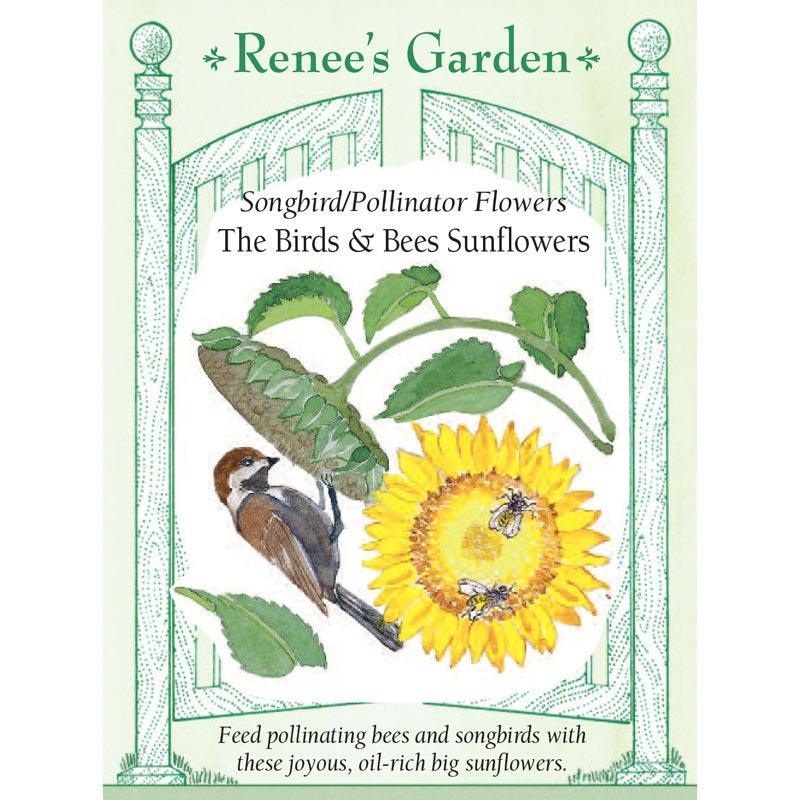Item Number: SWF5962
The Birds & Bees Songbird Sunflower Flower Seeds
A Rich Pollen and Nectar Source for Bees
Sunflower - Birds & Bees (Heirloom) - Helianthus annuus
Annual - Enhance your garden's eco-system with these sturdy, 6 - 8' tall sunflowers whose golden-yellow petals and chocolate centers seem to literally follow the sun. During blooming season they offer a rich pollen and nectar source for foraging honey bees, native bees and any other garden pollinators. At maturity, these black seeded sunflowers provide particularly oil-rich kernels with somewhat softer shells than others, yielding an abundance of nutritious feasts for birds.
Soil & Water:Make several sowings several weeks apart to have a succession of flowers in full bloom. Keep soil moist and well-weeded and protect very young seedlings from birds with netting or plastic berry baskets, removing before plants get crowded. Prefer good garden soil.Amend soil with a slow release fertilizer if soil is poor - not too high in nitrogen or flowers will be sparse.Once established, plants are somewhat drought tolerant./p>
Planting & Growing: To Plant Outdoors: Plant in full sun when weather is warm and settled both day and night and all danger of frost has passed. Poke seeds into well-worked soil about 1" deep, 4 - 5" apart. Press soil firmly over seeds and keep moist until seedlings emerge in 8 - 10 days. Thin to 12 - 15" apart when seedlings are large enough to handle. To Start Indoors: Several weeks before the last frost date, sow seeds 1" deep in individual pots of well-drained seed starting mix. Keep moist and provide a strong light source until ready to plant outside when seedlings are large enough to handle. When weather has warmed into the 50°F range, transplant 12" apart in full sun, disturbing the roots as little as possible.
Harvesting & Storage:As flowers bloom, bees pollinate the florets in each head and the seeds begin to mature. When the center disc florets have dried up, birds of all sorts will visit to snack on the ripening seed heads. To harvest fo feeding birds in the fall and winter, cover heads with paper bags till ripened kernels are plump and hard-shelled, then cut entire heads, let them fully dry and remove the seeds by hand or by rubbing over a wire screen into a basket. Store in closed containers to feed as needed.
Soil Temperature: above 50°FPlanting Depth: 1"
Germination: 8-10 Days
Height At Maturity: 6-7 feet
Sun/Shade: Full Sun
Spacing After Thinning: 12"
Approx Seeds per Pack: 110-115 Seeds
Check Your Zone Compatibility:
Compatible with your zone.
Growing Zone for

Our Guarantee To You
Since 1976, we've served our customers at every stage of growing. Please contact us at any time. We are happy to support and assist you.
Shipping Information
Shipping Information
Shipping Weight: 0.01 lb
Dimensions: 4.5"L x 3.125"W x 0.1"H
Features
Features
- Attracts Bees/Butterflies
- Does Not Require Support
- Good Cut Flower
- Good Fall Color
- Heat Tolerant
- Heirloom
- Requires Summer Water
- Somewhat Drought Tolerant
- Suited to Warmer Climates
- Useful for Ornamental
Characteristics
Characteristics
Planting & Care
Planting & Care
Planting: To Plant Outdoors: Plant in full sun in good garden soil when weather is warm and settled both day and night and all danger of frost has passed. Poke seeds into well-worked soil about 1/2" deep, 4 - 5" apart. Press soil firmly over seeds and keep moist until seedlings emerge in 8 - 10 days. Thin to 12 - 15" apart when seedlings are large enough to handle. To Start Indoors: Several weeks before the last frost date, sow seeds 1/2" deep in individual pots of well-drained seed starting mix. Keep moist and provide a strong light source until ready to plant outside when seedlings are large enough to handle. When weather has warmed into the 50°F range, transplant 12" apart in full sun, disturbing the roots as little as possible.
Growing: As flowers bloom, bees pollinate the florets in each head and the seeds begin to mature. When the center disc florets have dried up, birds of all sorts will visit to snack on the ripening seed heads. To harvest fo feeding birds in the fall and winter, cover heads with paper bags till ripened kernels are plump and hard-shelled, then cut entire heads, let them fully dry and remove the seeds by hand or by rubbing over a wire screen into a basket. Store in closed containers to feed as needed.
Useful Information
Useful Information
Guarantee
Guarantee
Share



10/10 recommend
I planted several in the ground and tried to start some inside to transfer outside. They simply aren't growing.
The kids and I loved watching the birds climb all over the heads, picking out seeds!



